Introduction to Sea Animals: Dive into the Ocean’s Wonders
Dive into the fascinating world of sea animals! Explore diverse marine life, from majestic whales to colorful coral reef inhabitants. Learn about unique adaptations, habitats, and conservation efforts. Discover amazing facts, stunning photos, and expert insights on ocean creatures. Your ultimate resource for all things aquatic!
Dolphins

Physical Characteristics:
Size: Dolphins vary in size depending on the species, ranging from 4 to 30 feet in length.
Color: Most dolphins have a sleek, streamlined body with colors ranging from light gray to dark gray, sometimes with lighter underbellies.
Body Structure: They have a dorsal fin on their backs, two pectoral fins, and a tail fin called a fluke. Their heads are characterized by a prominent forehead, known as a melon, which is used for echolocation.
Intelligence:
Dolphins are known for their high intelligence. They have large brains relative to their body size and exhibit complex behaviors and problem-solving abilities.
They can learn new behaviors, follow instructions, and even use tools.
Habits of Dolphins
Social Behavior:
Dolphins are highly social animals, often living in groups called pods. These pods can consist of a few individuals to over a thousand, depending on the species and environmental conditions.
They communicate with each other using a variety of sounds, including clicks, whistles, and body language.
Feeding Habits:
Dolphins are carnivorous, primarily feeding on fish and squid. They use sophisticated hunting techniques, such as herding schools of fish into tight balls for easy capture.
Some species, like the bottlenose dolphin, have been observed using tools, such as sponges, to protect their snouts while foraging on the ocean floor.
Reproduction:
Female dolphins give birth to a single calf after a gestation period of about 12 months. The calf is nursed for up to two years, during which time it stays close to its mother for protection and learning.
Other Information about Dolphins
Echolocation:
Dolphins use echolocation to navigate and hunt in the murky depths of the ocean. They emit high-frequency clicks and listen to the echoes that bounce back from objects, helping them determine the location, size, and shape of objects.
Habitat:
Dolphins are found in various marine environments, from shallow coastal areas to deep oceanic waters. Some species prefer warmer tropical and temperate waters, while others, like the orca (killer whale), can be found in polar regions.
Conservation Status:
While many dolphin species are abundant, some are endangered due to threats such as habitat loss, pollution, entanglement in fishing gear, and hunting.
Conservation efforts include protected areas, regulations on fishing practices, and public awareness campaigns to reduce human impact on dolphin populations.
Interaction with Humans:
Dolphins have a long history of interaction with humans, from ancient mythology and art to modern-day entertainment and research. They are often featured in marine parks and aquariums and are subjects of scientific studies due to their intelligence and complex behaviors.
They are also known to assist fishermen by driving fish into their nets and have been reported to help rescue humans in distress at sea.
Snowflake Clownfish
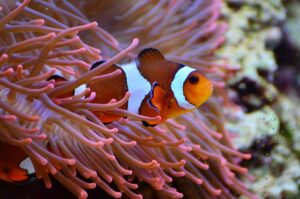
Info
Snowflake Clownfish
Physical Characteristics:
Size: Snowflake Clownfish, a variation of the Ocellaris Clownfish, typically grow to about 3-4 inches in length.
Color: They are known for their distinctive white patterns that resemble snowflakes against their vibrant orange bodies. The patterns vary among individuals, making each fish unique.
Body Structure: Snowflake Clownfish have a rounded body, a slightly forked tail, and fins with a slight orange hue. They also possess the iconic three white bands across their bodies, although these bands can be irregular in Snowflake variations.
Lifespan:
In captivity, they can live up to 10 years or more with proper care. In the wild, their lifespan may be shorter due to predation and environmental factors.
Habits of Snowflake Clownfish
Social Behavior:
Snowflake Clownfish are social and often found in pairs or small groups. In a group, there is a strict hierarchy with a dominant female at the top.
They exhibit symbiotic relationships with sea anemones, where they find protection from predators among the anemone’s stinging tentacles, to which they are immune.
Feeding Habits:
They are omnivores, primarily feeding on algae, plankton, and small invertebrates. In captivity, they can be fed a variety of foods, including flake food, pellets, and frozen or live brine shrimp and mysis shrimp.
Reproduction:
Clownfish are protandrous hermaphrodites, meaning they are born male and can change to female if the dominant female dies. The dominant male becomes the new female.
They lay their eggs on flat surfaces near their host anemone. The male guards and aerates the eggs until they hatch, usually in about 6-10 days.
Other Information about Snowflake Clownfish
Habitat:
In the wild, Snowflake Clownfish are found in the warm waters of the Pacific and Indian Oceans, often in coral reefs and shallow lagoons.
In captivity, they thrive in saltwater aquariums with plenty of hiding places and, ideally, a host anemone to mimic their natural habitat.
Conservation Status:
Snowflake Clownfish are not currently listed as endangered. However, habitat destruction and the aquarium trade can impact their populations.
Sustainable and ethical breeding practices in captivity help reduce pressure on wild populations.
Compatibility:
Snowflake Clownfish are generally peaceful and can coexist with other reef-safe fish in a community tank. However, they may become territorial, especially when breeding.
They are compatible with various corals and invertebrates, making them popular in reef aquariums.
Care in Captivity:
They require stable water conditions with a temperature range of 75-82°F, a pH of 8.1-8.4, and a salinity of 1.020-1.025.
Regular water changes and monitoring of ammonia, nitrite, and nitrate levels are essential for their health.
Providing a balanced diet and a stress-free environment with ample space and hiding spots will ensure their well-being.
Orca Whales
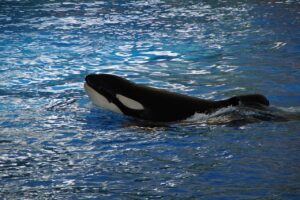
Info
Characteristics of Orca Whales
Physical Characteristics:
Size: Orca whales, also known as killer whales, are the largest members of the dolphin family. Adult males typically range from 20-26 feet in length and weigh between 8,000-12,000 pounds. Females are smaller, measuring about 16-23 feet and weighing between 3,000-8,000 pounds.
Color: Orcas have a distinctive black-and-white coloration. They have a black back, white chest and sides, and a white patch above and behind their eye.
Body Structure: They have a robust body with a large dorsal fin, which can be up to 6 feet tall in males. Their pectoral flippers are large and paddle-shaped.
Lifespan:
Orcas can live between 50-90 years in the wild, with females generally outliving males. In captivity, their lifespan is often shorter.
Habits of Orca Whales
Social Behavior:
Orcas are highly social and live in groups called pods, which can consist of up to 40 individuals. These pods are matrilineal, meaning they are led by the oldest female and include her descendants.
They exhibit strong family bonds, and members of a pod communicate using a variety of vocalizations, including clicks, whistles, and pulsed calls.
Feeding Habits:
Orcas are apex predators with a diverse diet that varies depending on their geographic location and the specific pod. They can prey on fish, squid, seals, sea birds, and even whales.
They use sophisticated hunting techniques, such as coordinated attacks and herding prey, and some populations have specialized in hunting specific types of prey.
Reproduction:
Female orcas give birth every 3-10 years after a gestation period of about 15-18 months. They typically give birth to a single calf, which stays with the mother and the pod for life.
Calves are nursed for up to two years, during which time they learn essential survival skills from their mother and other pod members.
Other Information about Orca Whales
Echolocation:
Like other dolphins, orcas use echolocation to navigate and hunt. They emit sound waves and listen for the echoes that bounce back from objects, allowing them to locate and identify prey and navigate through their environment.
Habitat:
Orcas are found in all of the world’s oceans, from the Arctic and Antarctic regions to tropical seas. They are most commonly found in colder coastal waters but can also be found in open ocean environments.
They are highly adaptable and can occupy a range of marine habitats, including coastal areas, deep waters, and even river mouths.
Conservation Status:
Orcas are not currently listed as endangered globally, but certain populations are considered endangered or threatened due to various threats, including habitat loss, pollution, and depletion of prey species.
Conservation efforts include protected marine areas, regulations on fishing practices, and research on their populations and behaviors.
Interaction with Humans:
Orcas have a complex relationship with humans. They are often featured in marine parks and aquariums due to their intelligence and trainability, though this practice is controversial.
In the wild, orcas have been known to interact with boats and even approach humans. However, they are wild animals and should be treated with respect and caution.
There are also historical accounts of orcas assisting fishermen by herding fish into nets in return for a share of the catch.
Cultural Significance:
Orcas hold significant cultural importance for many indigenous peoples, particularly those in the Pacific Northwest. They are often featured in folklore, art, and spiritual traditions.
They are also popular in modern media and have been the subject of numerous documentaries, books, and films, highlighting their intelligence, social complexity, and the challenges they face in the wild.
Jellyfish
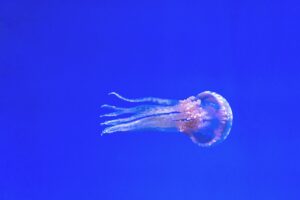
Info
Characteristics of Jellyfish
Physical Characteristics:
Body Structure: Jellyfish have a soft, gelatinous body with a bell-shaped top called the medusa. From the medusa hang tentacles that can vary in length. These tentacles contain specialized cells called cnidocytes, which house stinging structures called nematocysts used for capturing prey and defense.
Size: Jellyfish sizes range significantly depending on the species. Some are as small as a few millimeters, while others, like the Lion’s Mane Jellyfish, can have tentacles that stretch over 100 feet.
Color: They come in various colors, from clear or transparent to vibrant hues of blue, pink, red, and purple. Some species are bioluminescent, meaning they can produce their own light.
Lifespan:
Jellyfish lifespans vary widely among species. Some live only a few days, while others can live for several months or years. The Turritopsis dohrnii, known as the “immortal jellyfish,” can revert to its juvenile form after reaching maturity, potentially allowing it to live indefinitely under the right conditions.
Habits of Jellyfish
Movement:
Jellyfish move by contracting and relaxing their bell, propelling themselves through the water. However, they are largely at the mercy of currents and tides, which play a significant role in their movement.
Some species are capable of more directed swimming, but they typically drift along with the water currents.
Feeding Habits:
Jellyfish are carnivorous and primarily feed on small fish, plankton, and other marine invertebrates. They use their tentacles to sting and immobilize their prey before bringing it to their mouth located on the underside of the bell.
They have a simple digestive system, with a single opening that serves as both mouth and anus.
Reproduction:
Jellyfish have a complex life cycle that includes both sexual and asexual reproduction. The medusa form releases eggs and sperm into the water, where fertilization occurs. The resulting larvae, called planulae, settle on the ocean floor and develop into polyps.
Polyps can reproduce asexually by budding, creating new medusae that eventually detach and grow into adult jellyfish.
Other Information about Jellyfish
Ecosystem Role:
Jellyfish play a crucial role in marine ecosystems as both predators and prey. They help control plankton populations and provide food for a variety of marine species, including sea turtles, certain fish species, and seabirds.
Blooms, or large swarms, of jellyfish can have significant impacts on local marine environments, sometimes leading to the decline of fish populations.
Habitat:
Jellyfish are found in all of the world’s oceans, from the surface to the deep sea. They can thrive in a variety of environments, including coastal waters, open oceans, and even some freshwater lakes.
They are highly adaptable and can tolerate a wide range of temperatures, salinities, and oceanic conditions.
Conservation Status:
Most jellyfish species are not currently considered endangered, but changes in ocean conditions due to climate change, pollution, and overfishing can affect their populations.
Jellyfish blooms are becoming more common in some areas, potentially due to factors such as warmer sea temperatures and nutrient pollution.
Interaction with Humans:
Jellyfish stings can range from mild to extremely painful and, in some cases, can be life-threatening. The box jellyfish, found in the Indo-Pacific region, is one of the most venomous marine animals.
They can impact human activities by clogging fishing nets, damaging fishing gear, and causing problems for power plants and desalination facilities by blocking water intake pipes.
Research and Uses:
Jellyfish are studied for their unique biological properties, such as their simple nervous systems and regenerative abilities. Research on the immortal jellyfish has provided insights into aging and cellular regeneration.
Jellyfish are also being explored for their potential use in food, medicine, and biotechnology. In some cultures, they are considered a delicacy and are harvested for culinary purposes.
Seahorse
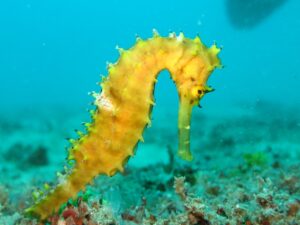
Info
Characteristics of Seahorses
Physical Characteristics:
Size: Seahorses range in size from about 0.6 inches to 14 inches in length, depending on the species.
Color: They come in various colors, including yellow, orange, red, grey, and black. Many species can change color to blend in with their surroundings.
Body Structure: Seahorses have a unique horse-like head with a long snout, a prehensile tail they use to anchor themselves to seagrass or coral, and a body covered in bony plates instead of scales.
Fins: They have a dorsal fin on their back and pectoral fins near the back of their head, which they use for locomotion.
Lifespan:
Seahorses typically live between 1 to 5 years in the wild, with larger species generally having longer lifespans.
Habits of Seahorses
Movement:
Seahorses are not strong swimmers. They use their dorsal fin to propel themselves forward and their pectoral fins to steer. They often rely on their prehensile tail to anchor themselves to objects in the water to avoid being swept away by currents.
Feeding Habits:
Seahorses are carnivorous and feed primarily on small crustaceans like brine shrimp, plankton, and other tiny marine organisms. They use their long snouts to suck in food, and because they lack teeth and a stomach, they must eat almost constantly to stay nourished.
Reproduction:
Seahorses have a unique reproductive process. The female deposits her eggs into a specialized brood pouch on the male’s abdomen, where he fertilizes them. The male carries the eggs in his pouch until they hatch, at which point he gives birth to live, fully-formed miniature seahorses.
Other Information about Seahorses
Ecosystem Role:
Seahorses play a role in maintaining the health of seagrass beds and coral reefs by controlling the population of small crustaceans and other organisms they feed on. They also serve as prey for larger marine animals.
Habitat:
Seahorses are found in shallow coastal waters around the world, from tropical to temperate zones. They inhabit seagrass beds, coral reefs, mangroves, and estuaries where they can find plenty of food and places to anchor themselves.
Conservation Status:
Many seahorse species are threatened by habitat loss, pollution, and overfishing. They are often caught unintentionally in fishing nets, and some are harvested for use in traditional medicine and the aquarium trade.
Conservation efforts include the establishment of marine protected areas, sustainable fishing practices, and breeding programs to help bolster wild populations.
Interaction with Humans:
Seahorses are popular in the aquarium trade due to their unique appearance and interesting behavior. However, they are difficult to care for in captivity and require specific conditions to thrive.
They are also used in traditional medicine in some cultures, where they are believed to have various health benefits.
Research and Uses:
Seahorses are studied for their unique reproductive biology, particularly the role reversal in pregnancy.
Their ability to camouflage and change color is also of interest to scientists studying animal behavior and physiology.
Protection Measures:
International trade of seahorses is regulated under the Convention on International Trade in Endangered Species of Wild Fauna and Flora (CITES) to help ensure their populations are not depleted by overharvesting.
Manatee

Info
Characteristics of Manatees
Physical Characteristics:
Size: Manatees are large, herbivorous marine mammals with adults typically ranging from 8 to 13 feet in length.
Weight: They can weigh between 800 to 1,200 kilograms (1,800 to 2,600 pounds).
Body Structure: Manatees have a rounded body with a paddle-shaped tail and flippers that resemble arms with three to four nails at the end. Their skin is thick and wrinkled, often covered in algae due to their slow movements.
Color: Their color ranges from gray to brown, and they may appear greenish due to algae growth on their skin.
Habitat and Range:
Manatees are primarily found in shallow, slow-moving rivers, estuaries, saltwater bays, canals, and coastal areas with abundant vegetation. They inhabit the warm coastal waters of the Atlantic Ocean, Gulf of Mexico, and the Caribbean Sea.
They are sensitive to cold temperatures and migrate to warmer waters during the winter months.
Diet:
Manatees are herbivores, feeding primarily on aquatic plants such as seagrasses, freshwater vegetation, and algae. They consume large quantities of vegetation daily, with adults eating up to 10-15% of their body weight in vegetation each day.
Behavior:
Manatees are slow-moving and gentle animals, spending most of their time grazing on vegetation. They are solitary animals or may gather in small groups, particularly during mating season or in areas with abundant food.
They are known for their calm demeanor and are often curious and friendly towards humans.
Reproduction:
Female manatees reach sexual maturity around 3-5 years old, while males mature slightly later. They have a gestation period of about 12 months, after which a single calf is born.
Calves are born underwater and can swim to the surface within minutes to take their first breath. They nurse underwater, staying close to their mother for up to two years before becoming independent.
Conservation Status:
Manatees are listed as vulnerable or endangered depending on the species and population. They face threats such as habitat loss due to coastal development, boat collisions, pollution, and entanglement in fishing gear.
Conservation efforts include habitat protection, manatee sanctuaries, boat speed regulations in manatee habitats, and public awareness campaigns to reduce human impacts.
Interaction with Humans:
Manatees have a long history of interaction with humans and are sometimes referred to as “sea cows.” They are curious and may approach boats, leading to accidental collisions.
Many regions have established sanctuaries and protected areas where human activities are regulated to minimize disturbances to manatees.
Cultural Significance:
Manatees are iconic animals in regions where they are found, often featuring in local folklore, art, and conservation efforts.
They are also studied for their unique adaptations to aquatic life and their role in coastal ecosystems as grazers and ecosystem engineers.
Sea Turtle

Info
Characteristics of Sea Turtles
Physical Characteristics:
Size: Sea turtles vary in size depending on the species. The largest species, the leatherback sea turtle, can reach lengths of over 6 feet and weigh up to 2,000 pounds. The smallest species, the Kemp’s ridley sea turtle, typically measures about 2-2.5 feet and weighs around 100 pounds.
Shell: They have a large, bony shell called a carapace that covers their back. The shape and coloration of the shell vary among species.
Flippers: Sea turtles have powerful, paddle-like flippers that enable them to swim long distances in the ocean. They use their front flippers for propulsion, while their rear flippers help steer.
Habitat and Range:
Sea turtles are found in all oceans except for the polar regions. They inhabit coastal areas, coral reefs, estuaries, and open ocean waters where they migrate long distances between feeding and nesting grounds.
They are known to travel thousands of miles during their lifetimes, crossing entire ocean basins.
Diet:
Sea turtles are primarily carnivorous when young, feeding on jellyfish, sponges, mollusks, and small fish. As adults, some species like the green sea turtle transition to a herbivorous diet, mainly feeding on seagrasses and algae.
Behavior:
Sea turtles are solitary animals outside of mating and nesting seasons. They are known for their long migrations between feeding and nesting grounds, guided by Earth’s magnetic field and environmental cues.
They spend most of their lives at sea, only coming ashore to nest and, occasionally, bask in the sun.
Reproduction:
Female sea turtles return to the beaches where they were born to lay their eggs, a behavior known as natal homing. They dig nests in the sand and lay clutches of eggs, which they cover with sand before returning to the ocean.
Incubation periods vary by species, but hatchlings typically emerge from the nest after about 6-10 weeks. They use natural light cues to find the ocean, and their journey is fraught with predators and obstacles.
Conservation Status:
All species of sea turtles are threatened or endangered due to human activities. Threats include habitat loss, pollution, climate change, bycatch in fishing gear, poaching of eggs and adults, and ingestion of marine debris.
Conservation efforts include protected marine areas, nesting beach monitoring and protection, reducing plastic pollution, implementing turtle-friendly fishing practices, and raising public awareness.
Interaction with Humans:
Sea turtles have cultural significance in many coastal communities and are symbols of wisdom, longevity, and resilience.
They are popular attractions for ecotourism, with many countries offering opportunities to observe them in their natural habitats while adhering to responsible wildlife viewing guidelines.
Research and Conservation Efforts:
Scientists study sea turtles to better understand their life cycles, migrations, feeding behaviors, and population dynamics.
Conservation organizations and governments collaborate on international agreements and initiatives to protect sea turtle habitats and populations worldwide. These efforts are critical for ensuring the survival of these ancient marine reptiles.
Octopus
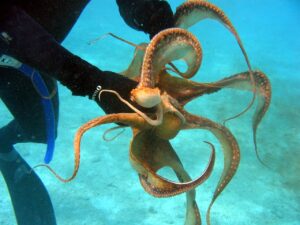
Info
Characteristics of Octopus
Physical Characteristics:
Body Structure: Octopuses have a soft, sac-like body with eight long arms (tentacles) that are lined with suckers. These arms are flexible and dexterous, allowing them to manipulate objects and capture prey.
Color and Camouflage: They are masters of camouflage and can change both color and texture to blend seamlessly with their surroundings. This ability is controlled by specialized skin cells called chromatophores.
Size: Octopuses vary in size, with the smallest species measuring about 1 inch in length and the largest, the giant Pacific octopus, reaching lengths of over 20 feet including arms.
Habitat and Range:
Octopuses are found in oceans worldwide, inhabiting diverse marine environments from shallow coastal waters to deep-sea habitats. They prefer areas with rocky bottoms, coral reefs, and crevices where they can hide and hunt.
Diet:
Octopuses are carnivorous and feed on a variety of prey, including crustaceans, mollusks, fish, and even other octopuses. They use their strong arms and powerful suckers to capture and manipulate their food.
Some species, like the mimic octopus, are known for their ability to imitate other marine animals as a hunting strategy.
Behavior:
Octopuses are solitary and typically live alone, except during mating season or interactions with potential prey or predators.
They are highly intelligent and have complex behaviors, including problem-solving abilities, tool use, and learning through observation.
Reproduction:
Octopuses have a relatively short lifespan, typically living from 1 to 3 years depending on the species.
Reproduction involves a complex courtship ritual where the male transfers sperm packets (spermatophores) into the female’s mantle cavity using a specialized arm called a hectocotylus.
Females lay thousands of eggs in a den or protected area, which they guard and aerate until they hatch. The female dies shortly after the eggs hatch, as she stops eating during the brooding period.
Conservation Status:
Many octopus species face threats such as habitat degradation, overfishing, and climate change. Some species are harvested for food, particularly in commercial fisheries.
Conservation efforts focus on sustainable fishing practices, habitat protection, and research to better understand octopus populations and behaviors.
Interaction with Humans:
Octopuses are of great interest to scientists studying marine biology, behavior, neurology, and robotics due to their intelligence and unique abilities.
They are also popular in aquariums, where their behaviors and problem-solving skills can be observed by visitors.
Octopuses have cultural significance in various societies, often appearing in myths, folklore, and art as mysterious and intelligent creatures.
Defense Mechanisms:
Octopuses have several defense mechanisms to protect themselves from predators, including camouflage, ink secretion (used to create a cloud of dark ink to confuse attackers), and the ability to escape through small openings due to their soft bodies.
Shark
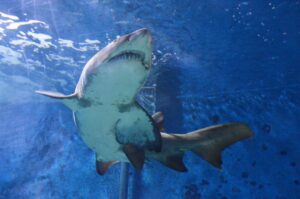
Info
Characteristics of Sharks
Physical Characteristics:
Body Structure: Sharks have a streamlined body with cartilaginous skeletons (cartilaginous fishes) that are lighter and more flexible than bones. They are known for their powerful jaws filled with rows of sharp, replaceable teeth.
Size: Sharks vary greatly in size, from the smallest dwarf lanternshark (measuring around 6-8 inches) to the largest whale sharks (which can reach lengths of over 40 feet).
Fins: They have several types of fins, including dorsal fins for stability, pectoral fins for steering, pelvic fins for balance, and caudal fins (tails) for propulsion.
Habitat and Range:
Sharks inhabit all oceans of the world, from shallow coastal waters to deep oceanic trenches. They can be found in tropical and temperate waters, and some species, like the Greenland shark, can survive in cold Arctic seas.
They are adapted to various marine environments, including coral reefs, open ocean, and even freshwater rivers.
Diet:
Sharks are carnivorous predators and have a diverse diet that includes fish, marine mammals, seals, sea birds, squid, and crustaceans. Some species are filter feeders (like the whale shark), while others are active hunters that chase down their prey.
Behavior:
Sharks are efficient hunters equipped with keen senses, including excellent vision, acute smell (detecting blood in water from great distances), and sensitive electroreceptors (detecting electrical signals emitted by prey).
They are apex predators at the top of the marine food chain, playing a crucial role in maintaining the balance of marine ecosystems.
Reproduction:
Sharks exhibit a variety of reproductive strategies, including viviparity (live birth), ovoviviparity (eggs hatch inside the female and young are born live), and oviparity (laying eggs externally).
Gestation periods and reproductive cycles vary widely among species. Some species, like the great white shark, have long gestation periods and give birth to relatively few young.
Conservation Status:
Many shark species are threatened or endangered due to overfishing, habitat loss, bycatch in fishing gear, and the demand for shark fins (used in shark fin soup).
Conservation efforts include establishing marine protected areas, regulating fisheries to prevent overexploitation, banning shark finning practices, and promoting sustainable fishing practices.
Interaction with Humans:
Sharks have been portrayed negatively in popular culture as dangerous predators, but most shark species are not aggressive toward humans and do not actively seek human prey.
Attacks on humans are rare, and most incidents involve mistaken identity or curiosity rather than predatory behavior.
Ecotourism activities, such as shark diving and snorkeling, allow people to observe sharks in their natural habitats while promoting conservation awareness and appreciation for these apex predators.
Research and Study:
Sharks are studied extensively by scientists to better understand their biology, behavior, migratory patterns, and ecological roles.
Research efforts contribute to conservation strategies aimed at protecting shark populations and ensuring their continued existence in marine ecosystems worldwide.
Squid
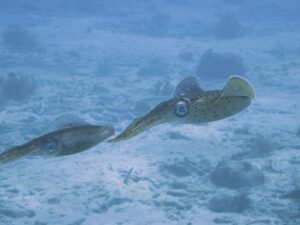
Info
Characteristics of Squid
Physical Characteristics:
Body Structure: Squid have elongated bodies with a distinct head, mantle (body), and arms. They are cephalopods, related to octopuses and cuttlefish, characterized by their bilateral symmetry and prominent eyes.
Size: Squid sizes vary by species. They range from small, such as the pygmy squid measuring around 1 inch, to large, like the colossal squid, which can exceed 30 feet in length.
Color and Camouflage: Squid have the ability to change color rapidly through chromatophores in their skin, allowing them to blend into their surroundings for camouflage or to communicate with others.
Habitat and Range:
Squid are found in all oceans and seas, from coastal waters to the open ocean. They inhabit a wide range of depths, from shallow waters to the deep sea, depending on the species.
They are highly adaptable and can migrate over long distances in search of food and suitable breeding grounds.
Diet:
Squid are carnivorous predators and feed on a variety of prey, including fish, crustaceans, and other mollusks. They capture their prey using their tentacles, which are equipped with suction cups and sharp hooks.
Some squid species are known for their aggressive hunting behaviors and use of bioluminescence to attract prey in the dark depths of the ocean.
Behavior:
Squid are active swimmers, propelled by powerful jet propulsion created by expelling water through a funnel-like structure called a siphon. This allows them to move quickly and escape from predators.
They are also capable of rapid movement using their fins and can hover or maneuver with precision using their arms and tentacles.
Reproduction:
Squid have a short lifespan, typically living from 6 months to 5 years depending on the species and environmental conditions.
Reproduction involves external fertilization, where males release sperm packets (spermatophores) into the water and females release eggs. Fertilized eggs develop into larvae that undergo metamorphosis into juvenile squid.
Conservation Status:
Squid populations are generally stable and not considered endangered. However, they can be impacted by changes in ocean conditions, pollution, and overfishing.
Squid play a crucial role in marine ecosystems as prey for numerous marine predators, including fish, seabirds, and marine mammals.
Interaction with Humans:
Squid are commercially important and harvested for food in many parts of the world. They are consumed fresh, dried, or processed into various seafood products.
They are also studied by scientists for their biology, physiology, and behavior, contributing to our understanding of marine ecosystems and biodiversity.
Research and Uses:
Squid have unique adaptations and biological features that make them valuable subjects for scientific research and technological advancements, including studies on camouflage, bioluminescence, and neurobiology.
Their ability to communicate through color changes and their complex nervous system provide insights into evolutionary biology and the diversity of life in the oceans.
Dugongs
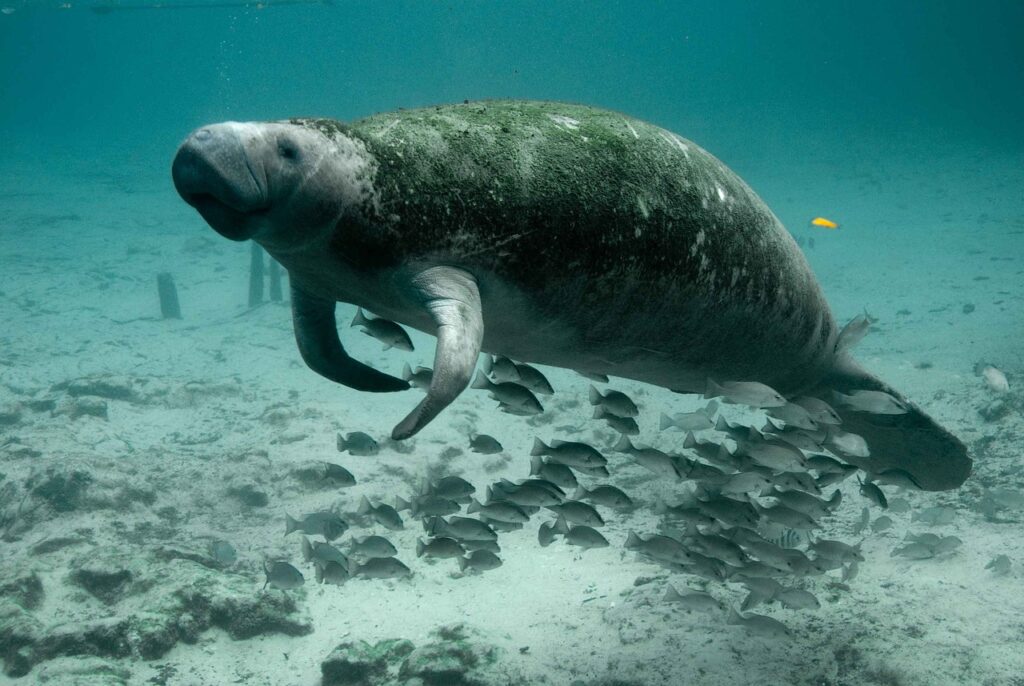
Dugongs, often called sea cows, are fascinating marine mammals that captivate both scientists and nature enthusiasts alike.
These unique creatures have been swimming in our oceans for millions of years, yet many people know little about them.
Let’s embark on an underwater journey to explore the world of dugongs, from their behavior and habitat to the challenges they face in today’s changing environment.
What Exactly is a Dugong?